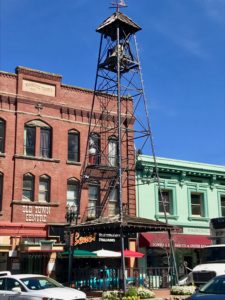 When I planted my first three books in Placerville, California, I didn’t give it a lot of thought. Okay, that might sound…casual, but I think in the back of my mind, Placerville was my Mayberry. It’s where I spent many summer days on my grandparents’ property off of Apple Hill Drive. It’s where life was simple and innocent. My fondest memories come from time spent there. I’ve always thought I was born in the wrong era. Wouldn’t it have been great to be a writer before social media became the major marketing tool?
When I planted my first three books in Placerville, California, I didn’t give it a lot of thought. Okay, that might sound…casual, but I think in the back of my mind, Placerville was my Mayberry. It’s where I spent many summer days on my grandparents’ property off of Apple Hill Drive. It’s where life was simple and innocent. My fondest memories come from time spent there. I’ve always thought I was born in the wrong era. Wouldn’t it have been great to be a writer before social media became the major marketing tool?
Ahh, but I digress.
Back to Placerville. This gold-rush town in the Sierra Foothills has a unique history. You can only imagine, a town once called “Hangtown” must have some kind of past. It was originally known as Dry Diggins, and was a gold mining camp along Hangtown Creek, established in 1848. This name came from the way the men moved cartloads of dry soil through running water to separate it from the gold. When I hear Dry Diggins I imagine a lack of booty, but by 1910, they boasted over $25 million in placer gold. Sounds anything but “dry” to me.
Placerville’s most common historical name, Hangtown, came from the many vigilante hangings that occurred. It was incorporated as the town of Placerville in 1854, and was, at that time, the third largest town in California. It was a stopping point for the Pony Express—which segues into quite an amazing story about Snowshoe Thompson (aka John Albert Thompson). He arrived in California with a herd of milk cows and settled near Placerville. After unsuccessfully trying his hand at gold mining, he decided a better use of his time would be to deliver mail from Placerville to Genoa (and later Virginia City), Nevada. Born and raised in Norway, Snowshoe Thompson (who didn’t actually use snowshoes) traveled the snow-covered mountains on 10-foot skies to deliver the mail between the years of 1856 and 1876. If this little teaser about Snowshoe leaves you wanting more, click here to read the full story.
In1856, several fires destroyed large sections of Placerville’s business community. The residents realized they needed a better system to alarm the Volunteer Fire Department when fires broke out. In 1860, they ordered a bell (to be cast in England) to use as an alarm. It didn’t arrive until 1865. In 1878, they built a 25-foot tower (constructed of wood) to house the bell. In 1898, they replaced the wood with steel. It has its own unique history, of which I only gave the highlights. If you have a hankering to know more, click here.
When I was growing up, Placerville was considered a quiet, quaint small town. Just recently, I was there to do a few videos (which will be aired the first week in May) and was disappointed by the traffic congestion. This may partly be due to road work they were doing on Mosquito Bridge (on Highway 50) so traffic was rerouted down Main Street. And really, how can you not feel a little nostalgia for a town that boasts a Mosquito Bridge?
I remember the Ben Franklin Five-and-Dime store, which Grandma would take me to. Sadly, it’s no longer there. They also had (and still have) the oldest (and coolest) hardware store west of the Mississippi. Seriously, if you’re ever in Placerville, you need to check out this store on Main Street. We actually did quite a bit of our Christmas shopping there a few years ago. It has everything you can imagine and is especially fun during the Christmas season.
Some of the well-known people who contributed to Placerville’s history are John Studebaker, Mark Hopkins, and Levi Strauss. More recent persons from this historic gold-mining town are Thomas Kinkade, Larry LaLonde (guitarist for Primus), Toby Hall (baseball player) and ski racer Spider Sabich.
Although Placerville is the setting for Surrendered, none of this history is in the novel. When we live in a place our whole lives, we often don’t give its history a lot of thought. How many of you live near an historic site that you’ve never visited? I know I have! And so it goes with the characters in my novels. Aside from a mention of Apple Hill, (more than 30 apple farms located around Placerville) which is a popular tourist spot, Tess and the gang are too busy navigating the complexities of life to go sight seeing.






Comments 1
Thank you for the history lessen on Placerville. As you know I too have many memories of being there, but I didn’t know much about Placerville. I do love Apple Hill though.